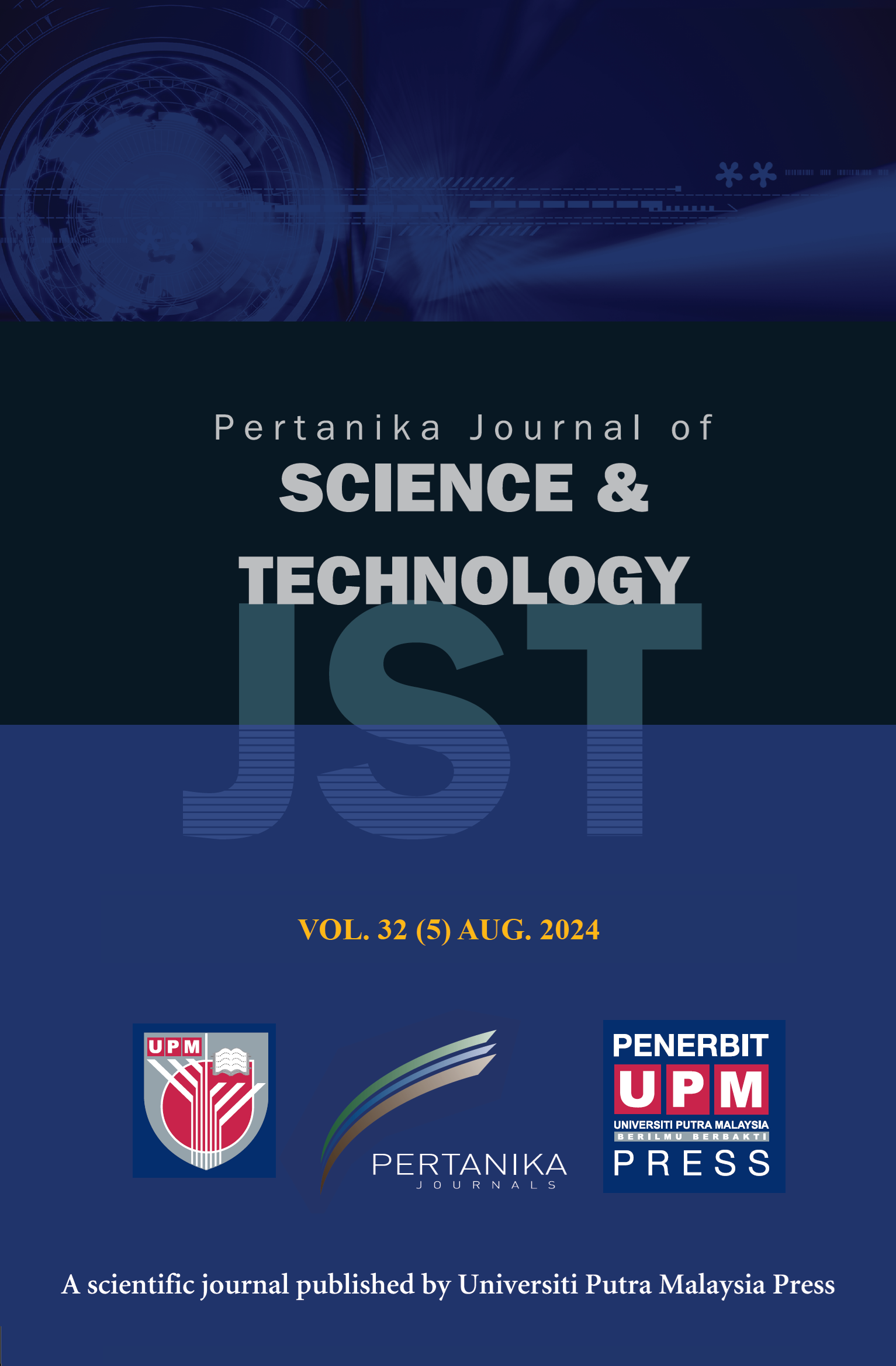PERTANIKA JOURNAL OF SCIENCE AND TECHNOLOGY
e-ISSN 2231-8526
ISSN 0128-7680
J
J
Pertanika Journal of Science & Technology, Volume J, Issue J, January J
Keywords: J
Published on: J
J
-
Adams, R. J., Wilson, M., & Wang, W. (1997). The multidimensional random coefficient multinomial logit model. Applied Psychological Measurement, 21(1), 1-23. https://doi.org/10.1177/0146621697211001
-
Alfayez, M. Q. E. (2022). Mathematical proficiency among female teachers of the first three grades in Jordan and its relationship to their mathematical thinking. Frontiers in Education, 7. Article 957923. https://doi.org/10.3389/feduc.2022.957923
-
Briggs, J. B., & Collis, K. (1982). Evaluating the quality of learning: The SOLO taxonomy. Academic Press. https://doi.org/10.1016/C2013-0-10375-3
-
Chinjunthuk, S., Junpeng, P., & Tang, K. N. (2022). Use of digital learning platform in diagnosing seventh grade students’ mathematical ability levels. Journal of Education and Learning, 11(3), 95-104. https//doi.org/10.5539/jel.v11n3p95
-
Corrêa, P. D., & Haslam, D. (2021). Mathematical proficiency as the basis for assessment: A literature review and its potentialities. Mathematics Teaching Research Journal, 12(4), 3-20.
-
Craig, O. (2021, June 29). What is STEM? https://www.topuniversities.com/courses/engineering/what-stem
-
Embretson, S. E. (2015). The multicomponent latent trait model for diagnosis: Applications to heterogeneous test domains.Applied Psychological Measurement, 39(1), 16-30. https://doi.org/10.1177/0146621614552014
-
Harris, C. J., Krajcik, J. S., Pellegrino, J. W., & DeBarger, A. H. (2019). Designing knowledge-in-use assessments to promote deeper learning. Educational Measurement: Issues and Practice, 38(2), 53-67. https://doi.org/10.1111/emip.12253
-
Howell, E., & Walkington, C. (2020). Factors associated with completion: Pathways through developmental mathematics. Journal of College Student Retention: Research, Theory & Practice, 24(1), 43-78. https://doi.org/10.1177/1521025119900985
-
Inprasitha, M. (2022). Lesson study and open approach development in Thailand: A longitudinal study. International Journal for Lesson and Learning Studies, 11(5), 1-15. https://doi.org/10.1108/IJLLS-04-2021-0029
-
Junpeng, P., Inprasitha, M., & Wilson, M. (2018). Modeling of the open-ended items for assessing multiple proficiencies in mathematical problem solving. The Turkish Online Journal of Educational Technology, 2, 142-149.
-
Junpeng, P., Marwiang, M., Chiajunthuk, S., Suwannatrai, P., Chanayota, K., Pongboriboon, K., Tang, K. N., & Wilson, M. (2020). Validation of a digital tool for diagnosing mathematical proficiency. International Journal of Evaluation and Research in Education, 9(3), 665-674. http://doi.org/10.11591/ijere.v9i3.20503
-
Leyva, E., Walkington, C., & Perera, H. (2022). Making mathematics relevant: An examination of student interest in mathematics, interest in STEM careers, and perceived relevance. International Journal of Research in Undergraduate Mathematics Education, 8, 612-641. https://doi.org/10.1007/s40753-021-00159-4
-
Maestrales, S., Zhai, X., Touitou, I., Baker, Q., Schneider, B., & Krajcik, J. (2021). Using machine learning to score multi-dimensional assessments of Chemistry and Physics. Journal of Science Education and Technology, 30, 239-254. https://doi.org/10.1007/s10956-020-09895-9
-
Organization for Economic Cooperation and Development. (2019). PISA 2018 results: What students know and can do. PISA OECD Publishing. https://doi.org/10.1787/5f07c754-en
-
Phaniew, S., Junpeng, P., & Tang, K.N. (2021). Designing standards-setting for levels of mathematical proficiency in measurement and geometry: Multidimensional item response model. Journal of Education and Learning, 10(6), 103-111. https//doi.org/10.5539/jel.v10n6p103
-
Rasch, G. (1960). Probabilistic models for some intelligence and attainment tests. The University of Chicago Press. https://doi.org/10.2307/2287805
-
Thailand Ministry of Education (2017). Learning standards and indicators learning of mathematics (revised edition 2017) according to the Core Curriculum of Basic Education, B. E. 2551. Agricultural Cooperative of Thailand. https://drive.google.com/file/d/1F4_wAe-ZF13-WhvnEAupXNiWchvpcQKW/view
-
Vongvanich, S. (2020). Design research in education. Chulalongkorn University Printing House.
-
Webb, N. L. (1997). Criteria for alignment of expectations and assessments in mathematics and science education. Council of Chief State School Officers. https://www.researchgate.net/publication/234731918_Criteria_for_Alignment_of_Expectations_and_Assessments_in_Mathematics_and_Science_Education_Research_Monograph_No_6
-
Wilson, C. D., Haudek, K. C., Osborne, J. F., Bracey, Z. E. B., Cheuk, T., Donovan, B. M., Stuhlsatz, M. A. M., Santiago, M. M., & Zhai. X. (2024). Using automated analysis to assess middle school students’ competence with scientific argumentation. Journal of Research in Science Teaching, 61(1), 38-69. https://doi.org/10.1002/tea.21864
-
Wilson, M. (2005). Constructing measures: An item response modeling approach. Lawrence Erlbaum Assoc. https://doi.org/10.4324/9781410611697
-
Wilson, M., & Sloane, K. (2000). From principles to practice: An embedded assessment system. Applied Measurement in Education, 13(2), 181-208. https://doi.org/10.1207/S15324818AME1302_4
-
Wright, B. D., & Stone, M. H. (1979). Best test design: Rasch measurement. Mesa Press. https://research.acer.edu.au/measurement/1/
-
Wu, M. L., Adams, R. J., Wilson, M. R., & Haldane, S. A. (2007). ACERConQuest version 2: Generalized item response modeling software. ACER Press. https://www.researchgate.net/publication/262187496_ConQuest_Version_2_Generalised_Item_Response_Modelling_Software
-
Zhai, X., Haudek, K. C., Shi, L., Nehm, R., & Urban-Lurain, M. (2020). From substitution to redefinition: A framework of machine learning-based science assessment. Journal of Research in Science Teaching, 57(9), 1430-1459. https://doi.org/10.1002/tea.21658
ISSN 0128-7680
e-ISSN 2231-8526




